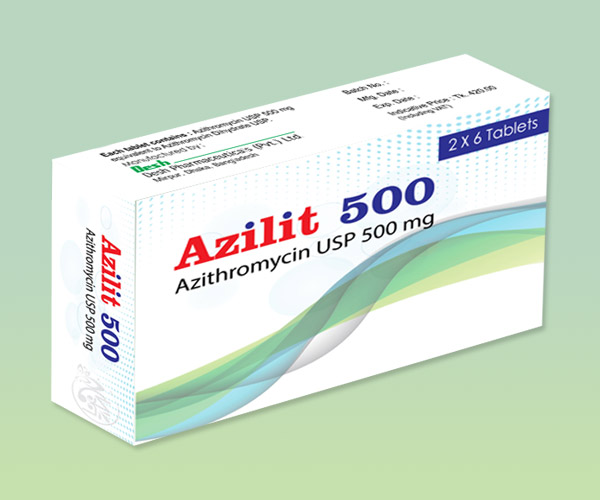Azilit 500
Azithromycin 500 mg
Azilit 500
Azithromycin 500 mg
Presentation
Azilit-500 Tablet: Each tablet contains Azithromycin USP equivalent to 500 mg anhydrous Azithromycin.
- AVAILABILITY: AVAILABLE
Pharmacology
Azithromycin is an azalide antibiotic, subclass of macrolide class of antibiotics. Azithromycin acts by binding to the 50S ribosomal subunit of susceptible organisms and thus interferes with microbial protein synthesis. Azithromycin demonstrated activity in vitro, against a wide range of gram-positive and gram-negative bacteria including: Staphylococcus aureus, Streptococcus pneumoniae, streptococcus pyogenes (group A) and other Streptococcus species; Hemophilus influenzae and parainfluenzae; Moraxella catarrhalis; anaerobic including Bacteroides fragilis, Escherichia coli, Bordetella pertussis, Bordetella parapertussis, Borrelia burgdorferi, Hemophilus ducreyi, Neisseria gonorrheae and Chlamydia trachomatis. Azithromycin is also demonstrated activity in vitro against Legionella pneumophila, Mycoplasma pneumoniae and hominis; Campylobacter spp., Toxoplasma gondii and treponema pallidum.
Indication
Azithromycin is indicated for infections caused by susceptible organisms, in lower respiratory tract infections including bronchitis and pneumonia, skin and soft tissue infections, otitis media and in upper respiratory tract infections including sinusitis, pharyngitis and tonsillitis.
Azithromycin is indicated in the treatment of uncomplicated genital infections due to Chlamydia trachomatis.
Dosage and administration
Adult:
Azithromycin should be given as 500 mg once daily orally for 3 days or as an alternative, given over 5 days with 500 mg on day 1, then 250 mg on days 2-5.
For sexually transmitted diseases caused by Chlamydia trachomatis in adults, the dose is 1 g given as a single dose.
A normal adult dose is recommended for elderly patients.
Children:
Over 6 months recommended dose is 10 mg/kg once daily for 3 days. Or,
Body weight 15-25 kg: 200 mg once daily for 3 days.
Body weight 26-35 kg: 300 mg once daily for 3 days.
Body weight 36-45 kg: 400 mg once daily for 3 days.
As common with other antibiotics, Azithromycin should be taken at least 1 hour before or 2 hours after meal and antacid.
Side effects
Azithromycin is well tolerated with a low incidence of side effects. The majority of side effects were mild to moderate in nature and of gastrointestinal in origin with nausea, abdominal discomfort, vomiting, flatulence and diarrhoea. Allergic reactions such as rash may have occurred and there have also been rare reports of serious hypersensitivity reactions. Reversible elevations in liver transaminases have been seen with a frequency similar to comparative macrolides and penicillins used in clinical trials. Transient mild reductions in neutrophil counts have occasionally been observed in clinical trials, although a causal relationship to Azithromycin has not been established.
Contraindication
It is contraindicated in patients hypersensitive to Azithromycin or any other macrolide antibiotic. Co-administration of ergot derivatives and Azithromycin is contraindicated. Azithromycin is contraindicated in patients with hepatic diseases.
Precaution
As with any antibiotic, observations for signs of superinfection with non-susceptible organisms, including fungi, is recommended. No dose adjustment is needed in patients with renal impairment.
Use in pregnancy and lactation
Animal reproduction studies have demonstrated that Azithromycin crosses the placenta, but have revealed no evidence of harm to the fetus. There are no adequate and well-controlled studies in pregnant women. Since animal reproduction studies are not always predictive of human response, Azithromycin should be used during pregnancy only if adequate alternatives are not available. No data on the secretion of Azithromycin in breast milk is available, so Azithromycin should only be used in lactating mothers where adequate alternatives are not available.
Overdosage & treatment
There is no data on overdosage with Azithromycin. Typical symptoms of overdosage with macrolide antibiotics include hearing loss, severe nausea, vomiting and diarrhoea. Gastric lavage and general supportive measures are indicated.
Drug interaction
Azithromycin absorption is reduced in the presence of food and antacid. So, Azithromycin should be administered 1 hour before or 2 hours after taking food or antacid. In patients receiving ergot alkaloids Azithromycin should be avoided concurrently because of the possibility of ergotism resulting from interaction of Azithromycin with the cytochrome P-450 system. However, no cases of such interaction have been reported. Macrolides have been known to increase the plasma concentration of digoxin and cyclosporin. Therefore, if co-administration is necessary, caution should be exercised and serum levels of digoxin and cyclosporin should be checked. There have been no pharmacokinetic drug interactions between Azithromycin and warfarin, theophylline, carbamazepine, methylprednisolone and cimetidine.
Pharmaceutical precaution
Store in a cool and dry place below 250C temperature, protected from light and moisture. Keep all medicines out of the reach of children.
Packing
Azilit -500 Tablet: Box containing 1 × 6/2 × 6 tablets in blister pack.
